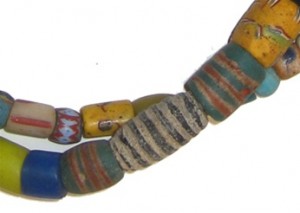Zulu Beads – The Hidden Love Letters of Africa
Bead adornment has long been used for communicative purposes, although it is largely the tribes of Southern Africa whom are renowned for the complexities of this visual communication method. During the thriving merchant era, certain types of trade beads (notably Chevrons) were highly sought after due to their rarity, or intricacy, and would therefore be worn by elders, Royalty and aristocracy to signify wealth, status and governing power.
But African trade beads weren't the only variant that bore significance as a correspondence tool. Zululand, in the heart of South Africa, is also known for a complex 'language', that uses both Zulu beads, and simple symbols such as the triangle, to convey non-verbal messages. The most common use for this communication method, is for love letters, in a society where it was once frowned upon for women to initiate the courting with men.
The Zulu bead language is built around the geometric triangle - each point bearing a significance to marital status, as does the positioning. Typically, if the point faces Southward, this denotes an unmarried woman, whereas if the apex points North, this signifies an unmarried man. Variants on both the orientation of the triangle, it's attachment to another, and the color of beads it is depicted against, all have an influence upon the message conveyed. Seven main bead colors tend to be used within the bead 'language', and although they all have primary meanings (i.e black connoting sadness, dismay and death); secondary definitions and messages can be created, as a result of the context in which Zulu beads are arranged. Different hues also influence context.
The most common colors used within the Zulu code are: green, which can symbolize contentment, yet also convey envy; blue which signifies longevity and faithfulness; red is strength of emotion, so can dictate love or anger; white for purity, honesty and neutrality of spirit; and finally pink, which added emphasis to a promise, and suggestion of fertility.
With such a beautifully simple language at their fingertips, both Zulu men and women found an avenue by which they could discuss and relay affairs of the heart, without doing so in public. The creative arrangement of Zulu beads allowed for more intricate expression, giving birth to several now well known Zulu love poems. One of these is "iNcwadi" ("I-en-che-wadi"), describing black as a depression due to a lover's absence, and green as the "springing of shoots", likened to the birth of love.
